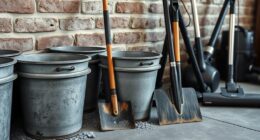Hello everyone! Are you prepared to take on the challenge of cleaning your wood stove pipe? No need to worry, as I am here to walk you through each step of the process.
Inside that dark, mysterious pipe lies a whole lot of soot and grime just waiting to be banished. But don’t you worry, with the right tools and a little know-how, we’ll have that pipe shining like new in no time.
So let’s get started, shall we?
Key Takeaways
- Assess the condition of the wood stove pipe regularly to ensure it is in good condition and free from wear and tear.
- Gather the necessary cleaning tools and materials, including a chimney brush and specialized creosote remover, to effectively clean the pipe.
- Prepare the wood stove for cleaning by removing ashes, disconnecting from power, and inspecting for damage or blockage.
- Clean the interior of the wood stove pipe by removing debris and soot buildup, using a creosote removal log and spray, and considering professional assistance if needed.
Assessing the Condition of the Wood Stove Pipe
I can’t believe how much creosote has built up inside the wood stove pipe! It’s crucial to regularly inspect the pipe to ensure it’s in good condition and free from blockages.
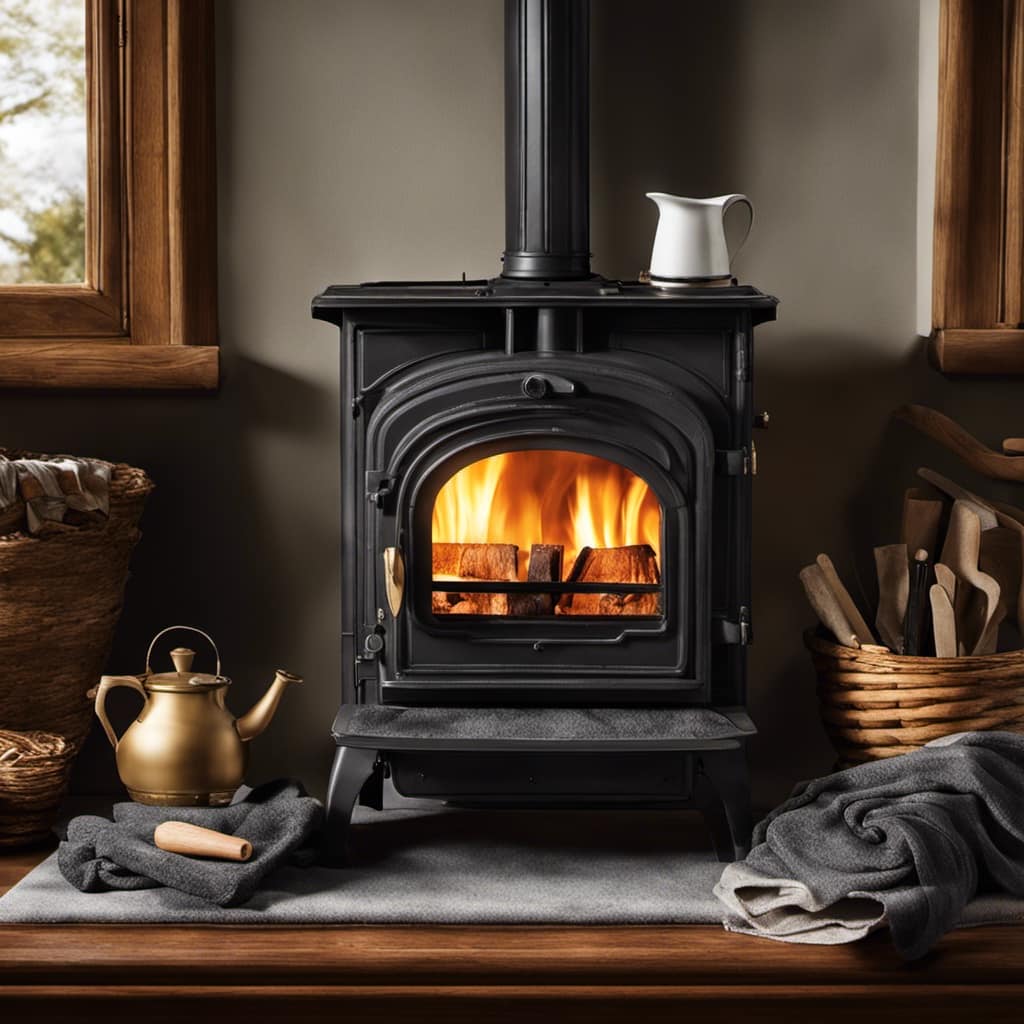
When inspecting, the first thing I look for are signs of wear and tear. This includes rust, corrosion, or any visible damage to the pipe. These signs can indicate potential issues that may affect the stove’s performance or even pose a safety hazard.
Additionally, I carefully examine the pipe for any blockages, such as soot or debris, that could restrict airflow and decrease the stove’s efficiency.
Gathering the Necessary Cleaning Tools and Materials
After assessing the condition of the wood stove pipe, I began gathering all the necessary cleaning tools and materials, including a chimney brush, creosote remover, and protective gloves. It’s crucial to choose the right cleaning solutions for the task at hand.
Using a specialized creosote remover can effectively break down and remove the built-up creosote inside the pipe, reducing the risk of chimney fires. Additionally, wearing protective gloves is essential to ensure safety while handling the cleaning solutions.
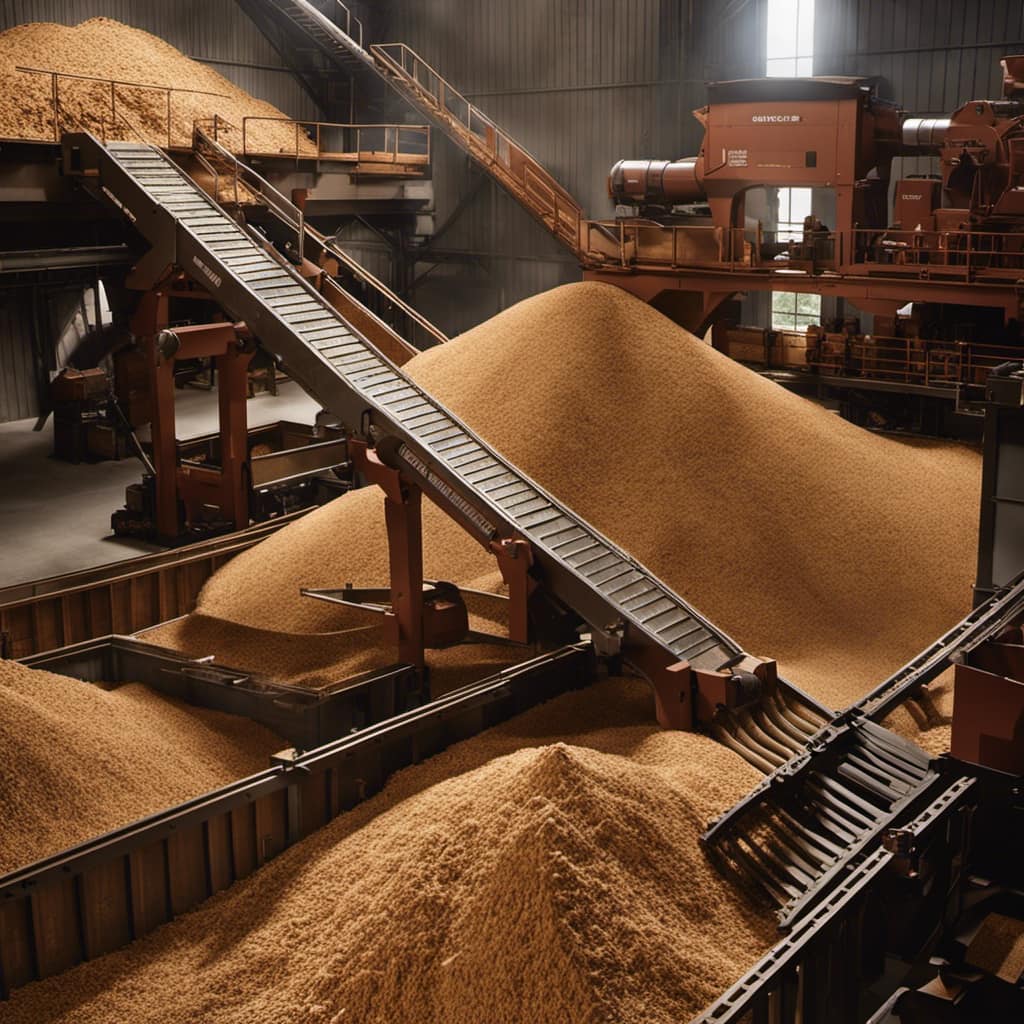
Proper disposal of debris is also important. Instead of simply discarding the debris, it’s recommended to collect it in a sturdy bag or container and dispose of it in accordance with local regulations.
Preparing the Wood Stove for Cleaning
To effectively clean the wood stove, I need to carefully remove the ashes from the firebox and then sweep the flue with a chimney brush. Before I begin cleaning the interior of the wood stove pipe, it is important to prepare the stove properly. This involves ensuring that the stove is cool and disconnected from any power source. I also need to inspect the pipe for any signs of damage or blockage. To assist with this, I have created a table below that outlines common wood stove pipe issues and troubleshooting steps:
| Common Issues | Troubleshooting Steps |
|---|---|
| Creosote buildup | Use a chimney brush to sweep the flue thoroughly |
| Cracked or damaged pipe | Replace the damaged section of the pipe |
| Blockage or obstructions | Clear the blockage using a pipe cleaning tool |
Cleaning the Interior of the Wood Stove Pipe
First, carefully remove any debris and soot buildup from the interior of the wood stove pipe, and then use a brush to sweep away any remaining residue. This step is crucial to ensure proper airflow and prevent any potential fire hazards. Once the initial cleaning is done, it’s time to focus on removing creosote, a highly flammable substance that can accumulate in the pipe.
Here are some effective cleaning techniques:
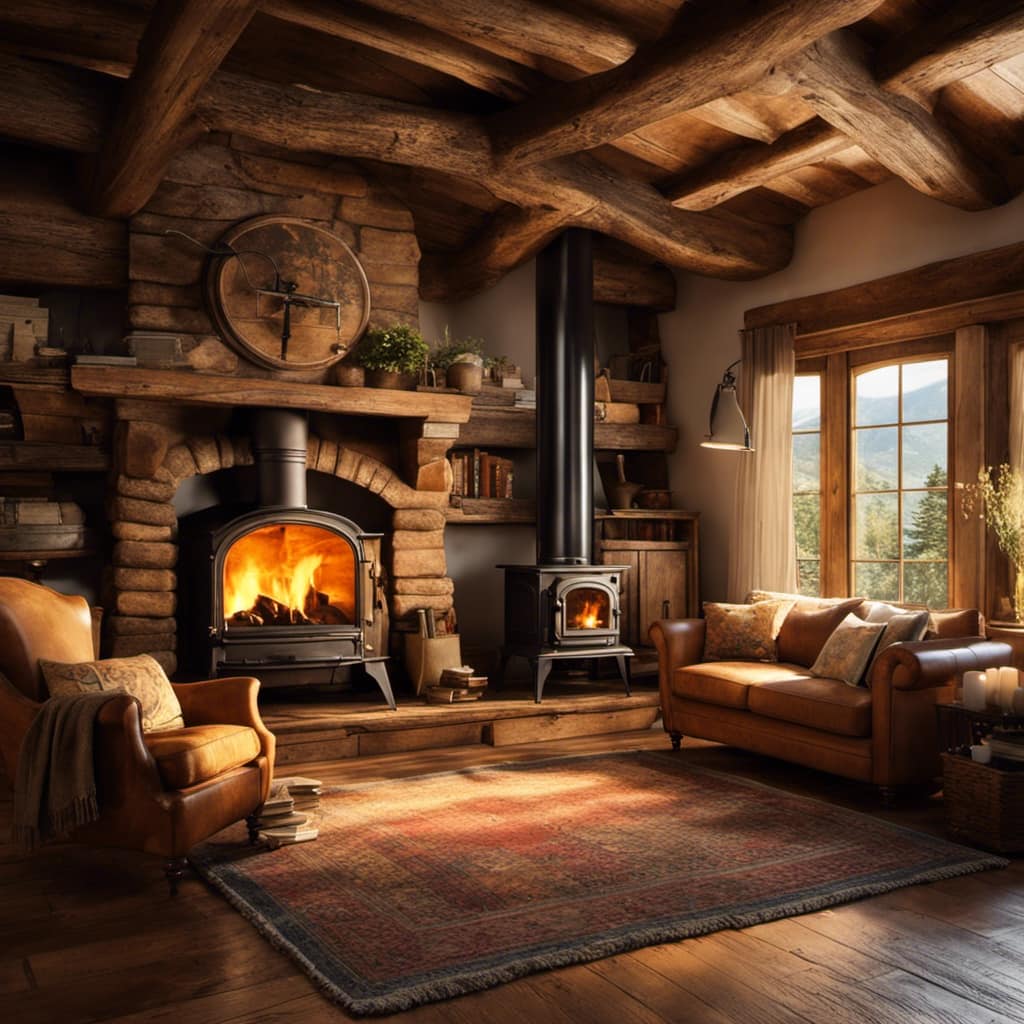
Use a creosote removal log: These logs are specifically designed to break down and remove creosote buildup when burned in the stove.
Use a creosote remover spray: Apply the spray directly onto the interior walls of the pipe, let it sit for a while, and then scrub it off with a brush.
Hire a professional chimney sweep: If you’re uncertain or uncomfortable with cleaning the wood stove pipe yourself, it’s always a good idea to seek the help of a professional.
Regular maintenance: To prevent excessive creosote buildup, make sure to clean the wood stove pipe at least once a year.

Maintaining and Preventing Future Build-Up in the Wood Stove Pipe
Regularly cleaning and inspecting the wood stove pipe is essential for preventing future build-up and ensuring the safe operation of the stove. One of the main concerns when it comes to wood stove pipes is the accumulation of creosote, a highly flammable substance that can lead to chimney fires. To prevent creosote buildup, it’s important to burn seasoned wood, as wet or unseasoned wood produces excess smoke and increases the likelihood of creosote formation.
Additionally, using a chimney brush to remove soot deposits from the pipe’s interior is crucial. This should be done at least once a year, or more frequently if you notice any buildup. Regular inspection of the pipe for any signs of damage or obstruction is also recommended to maintain optimal stove performance and safety.
Are the Techniques for Cleaning a Wood Stove Pipe Inside and Cleaning Wood Stove Metal the Same?
Yes, the techniques for cleaning a wood stove pipe inside and cleaning wood stove metal surfaces are similar. Both require regular maintenance to remove creosote buildup and ash residue. Using a wire brush and a vacuum will help ensure that the wood stove pipe and metal surfaces remain clean and safe to use.
Frequently Asked Questions
How Often Should I Clean the Interior of My Wood Stove Pipe?
I clean the interior of my wood stove pipe every year to ensure proper ventilation and prevent creosote buildup. Signs that it needs cleaning include reduced draft, excess smoke, and a strong odor.
Can I Use Regular Household Cleaning Products to Clean the Wood Stove Pipe?
I wouldn’t recommend using regular household cleaning products to clean the wood stove pipe. They may contain harsh chemicals that could damage the pipe. It’s better to use alternative cleaning methods that are safe and effective.

How Long Does It Typically Take to Clean the Interior of a Wood Stove Pipe?
To properly clean a wood stove pipe, it is important to follow a few tips for maintaining a clean interior. The time it typically takes can vary depending on the amount of buildup, but with regular maintenance, it shouldn’t take too long.
Is It Necessary to Remove the Wood Stove Pipe From the Stove in Order to Clean It?
Removing the wood stove pipe from the stove is not necessary to clean it. There are various cleaning methods, such as using a chimney brush or a vacuum, that can effectively remove the buildup of creosote and soot inside the pipe.
Can I Prevent Future Build-Up in the Wood Stove Pipe by Using Certain Types of Wood or Fuel?
To prevent future build-up in the wood stove pipe, it’s important to use dry, seasoned hardwoods for fuel. Avoid burning wet or green wood as it can lead to more creosote accumulation. Regular chimney inspections and cleanings are also essential for maintenance.
Conclusion
After assessing the condition of your wood stove pipe and gathering the necessary tools and materials, it’s crucial to properly clean the interior.
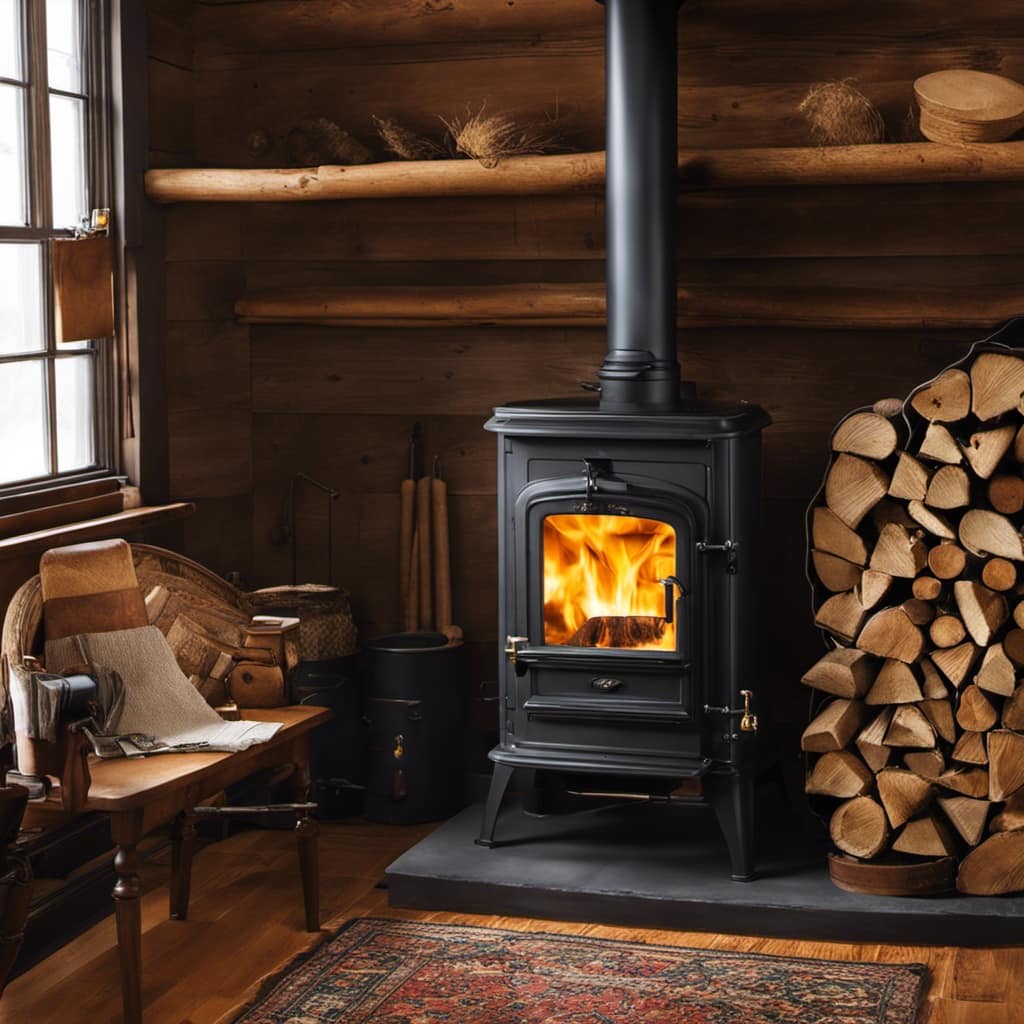
By following the steps outlined in this article, you can ensure that your wood stove pipe is free from debris and build-up, allowing for efficient and safe operation.
Regular maintenance and prevention measures will also help to extend the life of your wood stove pipe and minimize the risk of fire hazards.
Growing up surrounded by the vast beauty of nature, Sierra was always drawn to the call of the wild. While others sought the comfort of the familiar, she ventured out, embracing the unpredictable and finding stories in the heartbeat of nature.
At the epicenter of every remarkable venture lies a dynamic team—a fusion of diverse talents, visions, and passions. The essence of Best Small Wood Stoves is crafted and refined by such a trio: Sierra, Logan, and Terra. Their collective expertise has transformed the platform into a leading authority on small wood stoves, radiating warmth and knowledge in equal measure.










